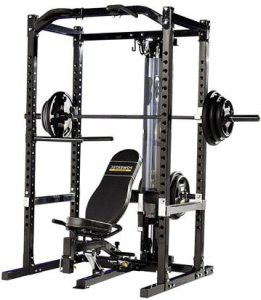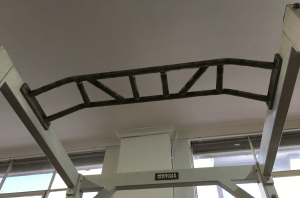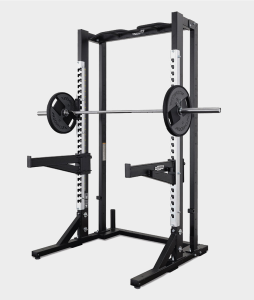Power Rack
I’m a huge fan of having a power rack for its multi-functional versatility, safety features, and the ability to add a multitude of attachments.
Suppose you have space at home and want to train safely and effectively with heavy free weight barbell exercises. In that case, a rack is an excellent investment for your home fitness gym.

A power rack, sometimes called a power cage, is simply a fully enclosed cage with four uprights, horizontal bars that act as bracing and adjustable safety bars. The uprights have a series of holes from top to bottom. These holes are for the safety bars and ‘J’ hooks that hold the barbell. You can adjust the safety bars and ‘J’ hooks to a comfortable height for you to perform a particular exercise.
Once you start getting stronger, the equipment you have may no longer challenge you to progress. For example, the dumbbell goblet squat might be a challenge for your upper body to hold a heavy dumbbell but not provide a challenging enough workout for your legs. As a result, the upper body will fatigue way sooner and not give the leg muscles enough stimulus.
You can load up a barbell for back squats in the right position with a power rack and do the exercise safely and effectively.
Safety features
Power racks provide you with peace of mind when lifting. One of the disadvantages of training at home is the lack of spotters when you want to attempt a heavy lift.
Well, not anymore. Power racks are great when you don’t have a spotter simply because of the adjustable safety bars. These bars, when set up correctly, act as your spotters.
Suppose you are doing an exercise like a barbell back squat or bench press, and you reach muscular fatigue or lose control of the barbell. In that case, you will be able to rest the barbell on the safety bars without getting hurt.
What to look for in a power rack
There are many power racks out there, ranging from a few hundred dollars to a few thousand dollars. Choosing the right rack will depend on your goals and what exercises you’re going to be doing. Here are some of the features to consider when choosing a rack:
Solid construction
A strong, sturdy, heavy-duty rack will last you a lifetime. I like a heavy rack (around 100kgs) with a deep frame and wide base. This provides an excellent, stable platform when doing exercises such as pull-ups, and you know that the rack is not going to shake or move around.
Adjustable hole spacing
I like a rack with the hole adjustments not too far apart. Good racks don’t exceed a 50mm (2”) spacing and should run from top to bottom. This allows you to customise the ‘J’ hooks and safety bars to a comfortable setting for you. They should also be numbered so you can quickly adjust the safety bars and hooks in the right position. Ok, you can always write the numbers on with a permanent marker.
Weight capacity
The rack should handle around 400 to 500kgs (1000lbs) of weight on the ‘J’ hooks and safety bars. Not that I would be able to lift that kind of weight, but at least you know it’s strong enough to handle a lot more weight than you can lift.
Quality safety bars
Secure and easy to change safety bars.
Attachment options
A good power rack will provide the option to add a series of attachments, such as a high and low pulley system, allowing you to perform a wide range of cable exercises. Also, dip bars, battle rope anchor, band pegs for resistance bands, spotter arms, and landmine attachment. Some even come with weight plate holders for storage.

Multi-grip pull up bar
Make sure you get a rack with the pull up bar attachment at the top. I like the ones with a multi-grip pull up bar attachment. This allows you to perform different grip pull ups and chin ups. You can also attach resistance bands at the top for performing resistance band exercises.

Full rack or half rack?
I prefer a full power rack rather than a half-rack because of the added safety features. You can perform a heavy lift, and rest assured if you lose control of the bar, it will fall within the cage on the safety bars and not on top of you.
That said, if you don’t have space at home for a full rack, then the half rack can still be a good choice. Just make sure to choose one that has adjustable safety bars or arms.